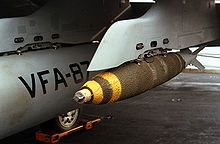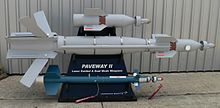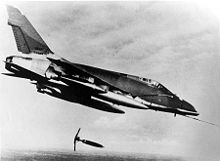- General-purpose bomb
-
A general-purpose bomb is an air-dropped bomb intended as a compromise between blast damage, penetration, and fragmentation in explosive effect.
Contents
Characteristics
General-purpose (GP) bombs use a thick-walled metal casing with explosive filler (typically TNT, Composition B, or Tritonal in NATO or United States service) composing about 50% of the bomb's total weight. (The British term for a bomb of this type is "medium case" or "medium capacity",(abbreviated to MC). The GP bomb is a common weapon of fighter bomber and attack aircraft because it is useful for a variety of tactical applications and relatively cheap.
General-purpose bombs are often identified by their weight (e.g., 500 lb, 250 kg). In many cases this is strictly a nominal weight, or caliber, and the actual weight of each individual weapon may vary depending on its retardation, fusing, carriage, and guidance systems. For example, the actual weight of a U.S. M117 bomb, nominally 750 lb (340 kg), is typically around 820 lb (374 kg).
Most modern air-dropped GP bombs are designed to minimize drag for the carrier aircraft.
In low-altitude attacks, there is a danger of the attacking aircraft being caught in the blast of its own weapons. To address this problem, GP bombs are often fitted with retarders, parachutes or pop-out fins that slow the bomb's descent to allow the aircraft time to escape the detonation.
GP bombs can be fitted with a variety of fuses and fins for different uses. One notable example is the "daisy cutter" fuse used on Vietnam-era American weapons, an extended probe designed to ensure that the bomb would detonate on contact (even with foliage) rather than burying itself in earth or mud, which would reduce its effectiveness.
GP bombs are commonly used as the warheads for more sophisticated precision-guided munitions. Affixing various types of seeker and electrically controlled fins turns a basic 'iron' bomb into a laser-guided bomb (like the U.S. Paveway series), an electro-optical guided bomb, or, more recently, GPS-guided weapon (like the U.S. JDAM). The combination is cheaper than a true guided missile (and can be more easily upgraded or replaced in service), but substantially more accurate than an unguided bomb.
History
British
- 40 lb General Purpose bomb - produced 1937 to 1941
- 50 lb General Purpose Bomb - not produced
- 120 lb General Purpose Bomb - abandoned project
- 250 lb General Purpose Bomb (1926 onwards) - replaced by 250 lb MC in 1942
- 500 lb General Purpose Bomb (1926 onwards) - replaced by 500 lb MC in 1942
- 1000 lb General Purpose Bomb (1939 onwards) - replaced by 1000 lb MC
- 1900 lb General Purpose Bomb (1941 onwards)
- 4000 lb GP (1943–1945)
Modern GP bombs
Modern American GP bombs: the Mark 80 series
During the Korean War and Vietnam War the U.S. used older designs like the M117 and M118, which had a higher explosive content (about 65%) than most current weapons. Although some of these weapons remain in the U.S. arsenal, they are little used, and the M117 is primarily carried only by the B-52 Stratofortress.
The primary U.S. GP bombs are the Mark 80 series. This class of weapons uses a shape known as Aero 1A, designed by Ed Heinemann of Douglas Aircraft as the result of studies in 1946. It has a length-to-diameter ratio of about 8:1, and results in minimum drag for the carrier aircraft. The Mark 80 series was not used in combat until the Vietnam War, but has since that time replaced most earlier GP weapons. It includes four basic weapon types:
- Mark 81 - nominal weight 250 pounds (113 kg)
- Mark 82 - nominal weight 500 pounds (227 kg)
- Mark 83 - nominal weight 1,000 pounds (454 kg)
- Mark 84 - nominal weight 2,000 pounds (907 kg)
Vietnam service showed the Mk 81 "Firecracker" to be insufficiently effective, and it was withdrawn from U.S. service. However, recently precision-guided variants of the Mk 81 bomb have begun a return to service, based on U.S. experience in Iraq after 2003, and the desire to reduce collateral damage compared to Mk 82 and larger bombs (e.g., when attacking a single small building in a populated area).
Since the Vietnam War, United States Navy and United States Marine Corps GP bombs are distinguished by a thick ablative fire-retardant coating, which is designed to delay any potential accidental explosion in the event of a shipboard fire. Land-based air forces typically do not use such coatings, largely because they add some 30 lb (14 kg) to the weight of the complete weapon.[citation needed]
In the Mk 80 series bomb bodies is also used in the following weapons:
- BDU-50 A practice (no explosive) version of the Mk 82 bomb body
- BDU-56 A practice (no explosive) version of the Mk 84 bomb body
Smart bomb kits
Dumb Mk 80 bombs could be smart bombs with attached kits:
- GBU-12D Paveway II (Mk 82) laser guided.
- GBU-16B Paveway II (Mk 83) laser guided.
- GBU-24B Paveway III (Mk 84) laser guided.
- GBU-38 JDAM (Mk 82) INS/GPS guided.
- GBU-32 JDAM (Mk 83) INS/GPS guided.
- GBU-31 JDAM (Mk 84) INS/GPS guided.
Retarded versions
- Mk 82 Snake Eye was a standard Mk 82 with folded, retarding petals.
- Mk 82 Retarded was a standard Mk 82 with a ballute.
- Mk 83 Retarded was a standard Mk 83 with a ballute.
- Mk 84 Retarded was a standard Mk 84 with a ballute.
Modern British GP bombs
The British describe general-purpose bombs as medium capacity (MC) bombs. The principal modern British bombs are 540 lb (245 kg) and 1,000 lb (454 kg), with a wide variety of fin, fuze, and retarder options.
The 1000 lb MC was developed from 1942 to replace the existing 1000 lb GP (General Purpose) bomb. Initially using most of the components of the 1000 lb GP it was decide to give it a new tail and was built with a half-inch thick wall. Fillings could be Amatex, Amatol, Minol, RDX and others. Actual weight was around 1020 lb (464 kg).[1] It was introduced to service in 1943 and about a quarter of a million produced by the end of the war.
Soviet / Russian GP bombs
The Russian term for general-purpose bomb is fugasnaya aviatsionnaya bomba, abbreviated FAB and followed by the bomb's nominal weight in kilograms. Most Russian iron bombs have circular ring airfoils rather than the fins used by Western types.
In 1946 the Soviet Union developed a series of freefall bombs in four sizes 250 kg (550 lb), 500 kg (1,100 lb), 1,500 kg (3,300 lb), and 3,000 kg (6,600 lb) and sharing a single nose and a single tail fuze. The bomb could be dropped from up to 12,000 m (40,000 ft) and up to 1,000 km/h (625 mph). The original, 1946-series bombs had poor ballistic characteristics at supersonic speed, and their construction was fragile. As an interim measure, upgraded versions of the bombs were built with thicker walls and no nose fuze. The thick-walled version of the bombs were built until 1956.
The 1954 series of high-drag bombs was built in six sizes: 250 kg (550 lb), 500 kg (1,100 lb), 1500 kg (3,300 lb), 3,000 kg (6,600 lb), 5,000 kg (11,000 lb), and 9,000 kg (20,000 lb). The smaller (less than 3,000 kg) bombs had a single nose and a single tail fuze, while the larger weapons shared a single nose fuze and two base fuzes. The FAB-9000 (9,000 kg / 20,000 lb) weapon was roughly comparable to the wartime Grand Slam bomb. Its use in the postwar era was apparently never seriously contemplated, but it was used by Russian aircraft designers as a substitute for early nuclear weapons when determining the size and clearances of bomb bays.
In 1962 a new series of streamlined, low-drag bombs was introduced, designed for external carriage by fighter-bomber aircraft rather than in internal bays. They come in only two sizes, 250 kg (550 lb) and 500 kg (1,100 lb). Both bombs have a single nose fuze.
Both the 54 and 62 series designs remain in use. The most common of these are the FAB-100, FAB-250, FAB-500, FAB-750, and FAB-1000, roughly corresponding to the U.S. Mark 80 series. These have seen widespread service in Russia, Warsaw Pact nations, and various export countries.
Larger bombs with less streamlined shapes also remained in the Soviet arsenal, primarily for use by heavy bombers. In Afghanistan in 1988 Soviet Tupolev Tu-22M bombers used massive FAB-1500 (1,500 kg / 3,300 lb) and FAB-3000 (3,000 kg / 6,600 lb) weapons to devastating effect.
French GP bombs
France's GP bombs, marketed by Matra and built by the Société des Ateliers Mécanique de Port-sur-Sambre (SAMP) are made in a variety of types with nominal weights from 50 kg (110 lb) to 1,000 kg (2,205 lb). The most common are the 250 kg (550 lb) EU2 and T25, 400 kg (882 lb) T200, and 1,000 kg (2,205 lb) BL4.
Other nations
Other countries, including Brazil, Chile, Israel, India, Portugal, Romania, South Africa, Spain, and Sweden, manufacture their own bombs, most of which are either licensed version of the U.S. Mark 80 series or close copies.
See also
- Unguided bomb
- Blockbuster bomb - chosen for blast effect
References
- Citations
- Bibliography
Lists relating to aviation General Aircraft (manufacturers) · Aircraft engines (manufacturers) · Airlines (defunct) · Airports · Civil authorities · Museums · Registration prefixes · Rotorcraft (manufacturers) · TimelineMilitary Accidents/incidents Records Categories:- Aerial bombs
Wikimedia Foundation. 2010.





